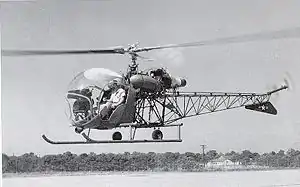| T51 | |
|---|---|
 | |
| The T51-powered Bell 201/XH-13F in a hover | |
| Type | Turboshaft |
| National origin | United States |
| Manufacturer | Continental Aviation and Engineering |
| Major applications | Bell 201 Sikorsky XH-39 |
| Developed from | Turbomeca Artouste |
The Continental CAE T51 was a small turboshaft engine produced by Continental Aviation and Engineering (CAE) under license from Turbomeca. A development of the Artouste, it was followed by three additional turboshaft engines, the T72, the T65, and the T67.[1] However, none of these engines, including the T51, entered full production. CAE abandoned turboshaft development in 1967 after the XT67 lost to the Pratt & Whitney Canada PT6T (T400) to power the Bell UH-1N Twin Huey.[1]
Variants and derivatives

Cessna XL-19C Bird Dog
- XT51-1
- (Model 210) Based on the Turbomeca Artouste I; 280 shp.[1]
- XT51-3
- (Model 220-2) Based on the Turbomeca Artouste II; 425 shp.[1]
- XT72
- (Model 217-5) Based on the Turbomeca Astazou; 600 shp.[1]
- XT65
- (Model 217-10) A scaled-down version of the Astazou; competed against the Allison T63 to power the Light Observation Helicopter; 305 shp.[1]
- T65-T-1
- [2]
- XT67
- (Model 217A) two engines driving a common gearbox; based on the Turbomeca Astazou X and T72; 1,540 shp.[1]
- Model 210
- Company designation for the XT51-1
- Model 217-5
- Company designation for the XT72
- Model 217-10
- Company designation for the XT65
- Model 217A
- Company designation for the XT67
- Model 217A-2A
- Company designation for the T67-T-1[2]
- Model 219
- similar to 220-2 with extra axial compressor stage
- Model 220-2
- Company designation for the XT51-3
- Model 227-4A
- Company designation for the T65-T-1[2]
- Model TS325-1
- Alternative company designation for the T65-T-1[2]
- Model 327-5
- Turboprop version of the T65-T-1[2]
Applications
.jpg.webp)
Sikorsky S-59 on display at the New England Air Museum
- XT51-1
- XL-19C Bird Dog
- Sikorsky XH-39 (S-59)
- XT51-3
- Bell 201 (XH-13F)
- XT67
- XT72
- Republic Lark (license-built Aérospatiale Alouette II)
Specifications (XT51-3)
Data from Aircraft engines of the World 1957[3]
General characteristics
- Type: Turboshaft
- Length: 45.1 in (1,150 mm)
- Width:17.8 in (450 mm)
- Height:21.5 in (550 mm)
- Diameter:
- Dry weight: 236 lb (107 kg)
Components
- Compressor: 1-stage centrifugal flow
- Combustors: annular compustion chamber
- Turbine: 2-stage axial flow
- Fuel type: JP-4
- Oil system: pressure spray at 20 psi (140 kPa)
Performance
- Maximum power output:
- Maximum power:425 shp (317 kW) at 34,800 rpm at sea level
- Maximum continuous power:375 shp (280 kW)at 34,800 rpm at sea level
- Overall pressure ratio: 3.9:1
- Air mass flow: 7 lb/s (190 kg/min)
- Turbine inlet temperature: TIT : 1,093.15 K (1,508.00 °F; 820.00 °C); JPT: : 838.15 K (1,049.00 °F; 565.00 °C)
- Fuel consumption: 370 lb/h (170 kg/h)
- Thrust-to-weight ratio: 1.887 lbf/shp (11.26 N/kW)
See also
Related development
Comparable engines
Related lists
References
- 1 2 3 4 5 6 7 Leyes II, Richard A.; William A. Fleming (1999). The History of North American Small Gas Turbine Aircraft Engines. Washington, DC: Smithsonian Institution. pp. 113–121. ISBN 1-56347-332-1.
- 1 2 3 4 5 Wilkinson, Paul H. (1966). Aircraft engines of the World 1966/77 (21st ed.). London: Sir Isaac Pitman & Sons Ltd. pp. 78–79.
- ↑ Wilkinson, Paul H. (1957). Aircraft engines of the World 1957 (13th ed.). London: Sir Isaac Pitman & Sons Ltd. p. 52.
Further reading
- Gunston, Bill (2006). World Encyclopedia of Aero Engines, 5th Edition. Phoenix Mill, Gloucestershire, England, UK: Sutton Publishing Limited. ISBN 0-7509-4479-X.
External links
This article is issued from Wikipedia. The text is licensed under Creative Commons - Attribution - Sharealike. Additional terms may apply for the media files.